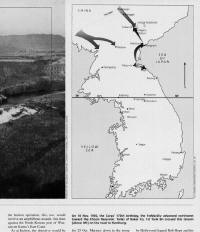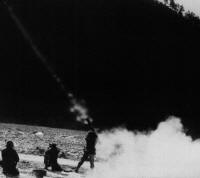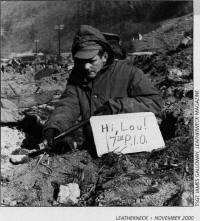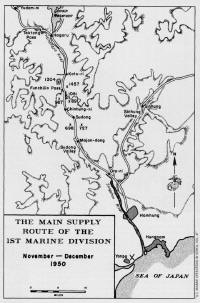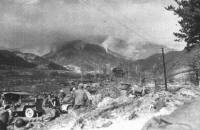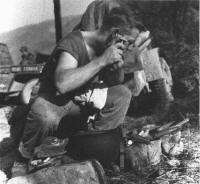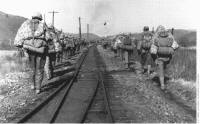 |
||||
 |
||||
Gene Dixon Memoir |
||||
|
||||
Korea, 1950: In the cold of far-off northern lands--Chosin |
||||
PART 1 |
||||
| Allan C Bevilacqua. Leatherneck. Quantico: Nov 2000.Vol. 83, Iss. 11; pg. 38, 7 pgs Copyright Marine Corps Association Nov 2000 |
||||
Imagine fighting a war in a place so inhospitable that the weather and terrain are every bit as hostile as the enemy. Imagine fighting a war amid towering, snow-clad mountains, deep in enemy territory at the end of a narrow, winding, icy road that is the sole link to your base of supplies more than 70 miles distant. Imagine fighting a war where the thermometer sinks to 35 degrees below zero and a wailing wind drives howling blizzards straight from the polar icecap. Imagine fighting a ruthless, fanatical enemy who outnumbers you by more than five to one and who has orders to annihilate you to the last man. Imagine all these things, and you have the situation confronting the First Marine Division in late 1950. On 8 Oct., fresh from the successful landing at Inchon and the liberation of the South Korean capital of Seoul, the division commenced backloading aboard ship, its sights set on a new mission. Like the Inchon operation, this, too, would involve an amphibious assault, this time against the North Korean port of Wonsan on Korea's East Coast. As at Inchon, the objective would be to intercept and cut off the retreat of North Korean People's Army (NKPA) forces back-pedaling in a frantic attempt to escape total destruction by advancing allied troops. After what seemed an interminable amount of backing and filling while the harbor at Wonsan was cleared of mines, D-day was finally set for 25 Oct. Marines down in the troop holds, always inventive and able to turn a phrase with the best, dubbed this interlude "Operation Yo-Yo." Even today, 50 years later, it is possible to get a feel for the chagrin of the Marines who waded ashore at Wonsan that day to find themselves greeted not by desperately resisting North Koreans, but by Hollywood legend Bob Hope and his traveling USO troupe. The North Korean retreat had become a rout, a devil-take the-hindmost stampede to flee complete catastrophe. The assault waves landed administratively to the accompaniment of suitably inventive sour comments. It was about as anticlimactic an operation as any in Marine Corps history. Lieutenant Joe Owen, a 60 mm mortar officer with "Baker" Company, 1st Battalion, Seventh Marine Regiment, found himself torn two ways. Relieved at being able to walk ashore unopposed, Owen was nonetheless mortified at splashing in to be greeted by ground crews from the First Marine Aircraft Wing who had come down to the beach to enjoy the show. Also among the onlookers were soldiers of the Republic of Korea (ROK) Army's Sixth Division that had spearheaded the drive up the East Coast. "They had learned the middle-finger salute," recalled Owen, "which they rendered to us with great enthusiasm." Neither Joe Owen nor anyone else who came ashore at Wonsan had any inkling that the war in Korea was about to take on a new dimension. Far to the north, in the most remote regions of North Korea, hundreds of thousands of Chinese communist soldiers, members of the People's Liberation Army, were crossing the Yalu River that separates Korea from Manchuria. Moving by night, hiding by day, they flowed southward undetected. While they did, the lstMarDiv prepared to execute its newest orders to advance to the north. The last elements of the division were barely ashore before evidence began to mount that the walk-in-the-sun atmosphere of the landing would not long endure. In the outlying hills around Wonsan were elements of three North Korean divisions, 2d, 5th and 10th, seriously reduced by casualties but still intact and willing to fight if conditions were right. Almost immediately there was contact, culminating in a regimental-size attack on Lieutenant Colonel Jack Hawkins' 1st Bn, 1st Marines at the small port of Kojo during the night of 27-28 Oct. Other smaller collisions crackled and sputtered in the days that followed, serving notice that there was still a war to be fought. Far more unsettling were the reports filtering down from ROK units operating farther north, reports that told of increasing contacts with Chinese communists. Similar encounters with Chinese troops were being reported by Eighth Army elements advancing northward in the western regions of Korea. The "Home for Christmas" scuttlebutt that had been making the rounds suddenly had less of a sound of certainty about it. Even though more and more evidence that China had entered the war was being uncovered, strangely it was largely discounted. Neither the senior command in the area, the Army's X Corps, nor General of the Army Douglas MacArthur's headquarters far away in Tokyo attached any great importance to it. There may be Chinese in Korea was the response. If there were, they were only a handful of "volunteers"-as though anything was voluntary in a communist army-allowed to join the faltering NKPA as a token show of solidarity. The wide gulf between the views of those in high places and of the men on the ground was soon to be demonstrated at a run-down village called Sudong. While Colonel Lewis "Chesty" Puller's 1st Marines were busied with maintaining security in the Wonsan area, the 5th Marines under LtCol Ray Murray and the 7th Marines commanded by Col Homer Litzenberg were already moving north. By the end of October, Litzenberg's 7th Marines had taken over responsibility for the industrial port of Hungnam, 70 miles up the coast from Wonsan, from the ROK I Corps. From there the mission of the 1st Mar Div would be to advance into the high mountain region of North Korea and secure the area about the Chosin Reservoir, then drive to the Manchurian border. t was envisioned by X Corps as a simple mopping-up operation. Homer Litzenberg didn't see it that way. Continuing ROK tales of "many, many Chinese" to the north caused Litzenberg to warn his subordinate commanders and NCOs, "We can expect to meet Chinese communist troops." As Litzenberg was speaking, an entire Chinese Army, the 42d, was taking up positions blocking the single road leading to the Chosin Reservoir. As dusk fell on 2 Nov., the 7th Marines settled into night defensive positions in the hills flanking the roadway just south of Sudong. In the lead was LtCol Ray Davis' 1st Bn, followed by Major Webb Sawyer's 2/7, with 3/7 under Maj Maurice Roach bringing up the rear and protecting the regimental trains. Not far away were all three regiments, 370th, 371st and 372d, of the Chinese Communist Forces' 124th Division supported by five Russian-made T34 tanks from the NKPA 334th Tank Regiment. At 2300 the probing thrusts that would soon come to be recognized as the preliminary to major CCF attacks began. By 0100 a full-scale assault was under way against 117 and 2/7. Added to the massed waves of infantry, the North Korean T34s entered the fray from the roadway to the north. The Chinese tactics soon became apparent: Attack at all points, maintain pressure everywhere, but always search for a gap. When a gap was found, flow through it and attempt to segment the defense. The fighting was intense, at times hand-to-hand, Marines and Chinese grappling in the darkness lit only by muzzle flashes and the bursts of mortar shells and grenades.
There were Marines equal to the task. Lt John Yancey, an enlisted World War II Marine Raider, now leading a platoon in Captain Walt Phillips' Easy Co, 2/7, led his men through a whirlwind of machine-gun bullets and grenades, shouting, "Run through it. Just follow me." Not far behind was Yancey's "platoon delinquent," Private Stanley Robinson. Robinson, a brig rat who had been brought aboard ship in San Diego in handcuffs, took command of his squad after Sergeant Rugierre Cagliotti fell, leading it fearlessly in a headlong charge. In Capt Myron Wilcox's Baker, 1/7, Lt Chew Een Lee, the first Marine officer of Chinese descent, barreled into the attackers, spraying them with bullets and curses in their native tongue. Shadowing Lee closely was his self-appointed bodyguard, Italian-born Private First Class Attilio Lupacchini, Browning Automatic Rifle barking at any Chinese who offered a threat to the diminutive Lee. Staff Sergeant Archie Van Winkle earned the Medal of Honor there, leading a counterattack into withering fire despite two severe wounds, encouraging his men until he collapsed from loss of blood. Only heroic measures by Navy medical personnel prevented him from dying. The fighting between the 7th Marines and the CCF 124th Division raged throughout the night and the following day before the Chinese had enough. The outcome had been bitterly contested, but in the end, the CCF 124th Division broke itself on the rock of Marine firepower and Marine determination. When night gave way to dawn on 4 Nov., the badly mauled CCF 124th Division had ceased to exist as a significant fighting force. The advance northward continued, and on 10 Nov., the Marine Corps birthday, Marine units had reached the ramshackle collection of huts that made up the village of Koto-ri, 11 miles from the southern tip of the Chosin Reservoir. There were no Chinese to be seen. The lack of a visible Chinese presence did not for a minute lead the 1stMarDiv Commanding General, Major General Oliver P. Smith, to believe there were no longer large numbers of Chinese in the area. In private correspondence to Gen Clifton B. Cates, Commandant of the Marine Corps, on 15 Nov., Smith wrote: "I do not like the prospect of stringing out a Marine division along a single mountain road for 120 miles from Hamhung to the Manchurian border." The division's commanding general pointedly added: "I have little confidence in the tactical judgement of X Corps or the realism of their planning." Under relentless pressure to cast caution to the winds and make a helter-skelter sprint northward, MajGen Smith resolved to advance methodically, building up adequate stocks of supplies to meet any contingency. That contingency was waiting in the form of Gen Sung Shih-lun's 9th Army Group, a force of 15 divisions totaling some 100,000 men. As the Marines advanced higher and higher into the forbidding mountains, another enemy appeared on the scene. Winter arrived in full force, sending the temperature plunging below zero, making the ground a rock-hard barrier that defied the most muscular efforts with an entrenching tool. Snow began to fall, turning the roadway into a skating rink. Rations froze solid. Canteens burst from the pressure of the ice in them. Frostbite began to appear among men exposed to the relentless wind and cold. Resourceful Marines who managed to boil a canteen cup of C-ration coffee were dumbfounded to find a skim of ice on their brew only minutes after removing it from the fire. Only regular working of the actions of rifles and machine guns prevented the traditional "light coat of oil" from freezing. Soon the oil disappeared, to be replaced by, of all things, a popular brand of hair tonic. The stuff worked just fine. With the arrival of the waning days of November, the entire 1stMarDiv was shifting ever northward, 7th Marines in the lead, followed by the 5th Marines, while the 1st Marines, freed from security duties around Wonsan, were establishing intermediate bases at Chinhung-ni and Koto-ri. By Thanksgiving Day, 24 Nov., Col Litzenberg's 7th Marines had occupied the town of Hagaru-ri at the southern tip of the Chosin Reservoir and were sending patrols to the flyspeck village of Yudam-ni, farther north on the reservoir's western shore. LtCol Murray's 5th Marines were operating to the east along the opposite bank. Engineers of LtCol John Partridge's Ist Engineer Bn were already at work around the clock scraping out a 5,000-foot runway at Hagaru-ri. Mountains of supplies, enough for two weeks of fighting, were being built up. By some minor miracle there was a turkey dinner with all the trimmings on Thanksgiving Day itself. As one veteran of the campaign recalled years later: "The gravy froze first, then the mashed potatoes. The turkey was still a little warm in the middle, if you ate real fast." None of the men who lined up for chow call that day knew it, but Thanksgiving dinner would be the last full meal most of them would eat for more than two weeks. Sgt Irvin R. "Dick" Stone, an assault section leader with Weapons Co, 115, didn't get even that. On a hillside outpost Stone's Thanksgiving dinner consisted of a can of C-ration meat and noodles, frozen solid. He threw away the can and contented himself with gnawing at the bar of chocolate that came in the ration box. MajGen Smith's concerns for the scattered nature of his units were eased on 26 Nov., when the 5th Marines on the east side of the reservoir were relieved by elements of the 7th Infantry Division and began joining the 7th Marines at Yudam-ni. It wasn't until after nightfall on the 27th that the last of the 5th Marines, LtCol John Stevens' 1/5, completed the march to Yudam-ni. They were none too soon. At that moment there were more than 300,000 Chinese troops in North Korea, a solid third of them in the zone of the 1stMarDiv. Sometime around 2200-no one has ever been certain of exactly when-as the thermometer skidded toward 20 degrees below zero, they struck. To the accompaniment of an unholy din of bugles, whistles, gongs, horns, cymbals and drums, shouting "Marine, we kill! Marine, you die!" the assault battalions of the CCF 79th and 89th Divisions launched massed attacks against units of the 5th and 7th Marines holding the hills surrounding Yudam-ni. Illumination shells, bursting high-explosive rounds and thousands of muzzle flashes revealed swarms of Chinese surging up the bare hillsides toward the Marine lines, driving home their attacks by sheer weight of numbers. Marine firepower cut fearful swaths through their ranks. Still they came on. Where one fell another took his place. "You couldn't kill them fast enough," was one Marine's comment.
Casualties were mounting among the Marines as well. The two platoons of Capt Leroy Cooke's How, 3/7, holding grimly to their position on Hill 1403, were particularly hard hit. Determined to break through the Marine lines at any cost, the Chinese attackers came in waves, unarmed soldiers in the rear ranks picking up weapons from the dead who had fallen in front of them. The evenly spaced ranks of Chinese reminded PFC Robert Cameron, a machine-gunner, of the weekly Saturday morning parades at Parris Island, S.C. Firing in disciplined short bursts, in what seemed like no time at all, Cameron found himself working on his fourth 250-round can of ammunition. With masses of Chinese sweeping past their unprotected flanks, with Capt Cooke, himself, dead and half of the defenders of the hill casualties, Cameron and his fellow Marines were finally ordered to withdraw to a less exposed position to prevent their being wiped out. Were the attacking Chinese intent upon using their own bodies to bury the Marines? It seemed that way. To How Co's left, the positions of LtCol Hal Roise's 2/5 were under an equally fierce onslaught. Just a year earlier Roise had been the head coach of the Camp Pendleton, Calif., football team, preparing his gridders to meet Quantico, Va., in the All-Navy championship game before 45,000 spectators in the Los Angeles Coliseum. Now there appeared to be that many Chinese assailing Roise's lines. Rank after rank of them flung themselves against Roise's two forward companies, Easy and Fox. They were shot down in windrows, bodies tumbled atop bodies, but still they came on. Inevitably the weight of numbers produced local breakthroughs. They were sealed off and thrown back. It was a goal line stand of a different sort. The battalion held. he situation was no less tense on the hills to the right of Hill 1403 in the sector of 2/7. The Marines of Capt Walt Phillips Easy Co on Hill 1282 and Capt Milt Hull's Dog Co on neighboring Hill 1240 were confronted by their own seas of Chinese attackers as the fighting descended into hand-to-hand savagery. Casualties on both sides were crippling. The slopes of both hills were covered with the human wreckage of repeated Chinese attacks. The ranks of the defenders were no less fearfully depleted. After a night of constant combat, Easy Co had been reduced to the strength of less than a single platoon, all of its officers except one killed or wounded. Twice wounded but continuing to lead, Milt Hull, who would receive the Navy Cross for his night's work, could muster only 16 Dog Co Marines still on their feet and able to fight. It was the same story on all of the hills overlooking Yudam-ni. The nondescript town in the middle of nowhere was ringed with fire. Even as the CCF 79th and 89th Divisions hurled themselves at the Marine defenses in an all-out effort to destroy the 5th and 7th Marines, another CCF division, the 59th, was swinging around Yudam-ni to sever the road leading to Hagaru-ri. When dawn finally broke after a night of attack and counterattack, the lines of the 5th and 7th Marines, dented and battered, still held. But they were completely surrounded by an enemy determined to annihilate them to the last man. |
||||
|
||||
 |
